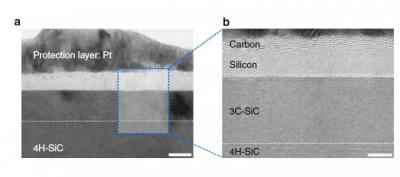Researchers at the Institute for Basic Science (IBS) and KAIST have designed a graphene synthesis mechanism using laser-induced solid-state phase separation of single-crystal silicon carbide (SiC). According to the scientists, the laser material interaction technology can be a powerful tool for the next generation of 2D materials.

Using molecular dynamic simulations and high resolution microscope images, the researchers discovered that a single-pulse irradiation of xenon chloride excimer laser of 30 nanoseconds melts SiC, causing the separation of a liquid SiC layer, a disordered carbon layer with graphitic domains (approximately 2.5 nm thick) on the top surface and a polycrystalline silicon layer (roughly 5 nm) below the carbon layer. The sublimation of the separated silicon is caused when additional pulses are given, while the disordered carbon layer is changed into a multilayer graphene.